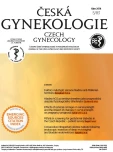Advance maternal age – risk factor for low birhtweight
Authors:
T. Vlachová 1; J. Kocourková 1; Tomáš Fait 2
Authors‘ workplace:
Katedra demografie a geodemografie, Přírodovědecké fakulty UK, Praha, vedoucí RNDr. T. Kučera, CSc.
1; Gynekologicko-porodnická klinika 2. LF UK a FN Motol, Praha, přednosta MUDr. R. Chmel, Ph. D., MHA
2
Published in:
Ceska Gynekol 2018; 83(5): 337-340
Category:
Overview
Objective:
To determinate correlation between childbearing postponement and low birthweight prevalence in Czech population.
Design:
Population study.
Methods:
Year books of Czech Statistical Office from 1990 to 2015 were used as sources of data. Analysis was done by simple linear regression method.
Results:
The proportion of children borned by women older than 35 years have rised from 4% to 21% from 1990 to 2015. In the same time the percentage of low birthweight have increased from 5,7 do 7,6. The coefficient of determination, which shows the ratio of explained variability to common variability of this ratio, reach R2 = 0,88.
Coclusion:
The enlargement of life-borned low birthweight children is owing by 88% on account of childbearing postponement.
Keywords:
advanced maternal age, low birthweight
Sources
1. Český statistický úřad: Demografické ročenky (pramenná díla) 1986-2015 z: https://www.czso.cz/csu/czso/casova_rada_demografie.
2. de Bernabé, VJ., Soriano, T., Aldalaberjo, R., et al. Risk factors for low birth weight: a review. Eur J Obstet Gynecol Reprod Biol, 2004, 116(1), p. 3–15.
3. Cleary-Goldman, CJ., Malone, D., Vidader, J., et al. Impact of maternal age on obstetric outcome. Obstet Gynecol, 2005, 105(5, Part 1), p. 983–999.
4. Delbaere, I., Verstraelen, H., Goetgeluk, S., et al. Pregnancy outcome in primiparae of advanced maternal age. Eur J Obst Gynecol Reprod Biol, 2007, 135(1), p. 41–46.
5. Hájek, Z. Rizikové a patologické těhotenství. Praha: Grada, 2004, s. 443.
6. Institute of medicine. Preventing low birthweight: summary [online]. Washington, D.C.: National Academy Press, 1985, 41 s.
7. Jacobsson, B., Ladfors, L., Milsom, I. Advanced maternal age and adverse perinatal outcome. Obstetrics, 2004, 104(4), p. 727–733.
8. Kocourková, J. Reprodukční stárnutí české populace. Gyn Por, 2018, 2(1), s. 4–7.
9. Kramer, MS. Determinants of low birth weight: methodological assessment and meta-analysis. Bulletin of WHO, 1987, 65(5), p. 663–737.
10. Lamminpaa, R. Increased risk of gestational diabetes for mothers aged over 35. Diab Res Wellness Found 2015. z: https://www.drwf.org.uk/news-and-events/news/increased-risk-gestational-diabetes-mothers-aged-over-35.
11. Lubušký, M., Krofta, L. Péče o těhotenství s intrauterinní růstovou retardací plodu – doporučený postup. Čes Gynek, 2013, 78, Suppl., s. 48.
12. Millar, WJ., Chen, J. Maternal education and risk factors for small-for-gestational-age births. Health Reports, 1998, 10(2), p. 43–51.
13. Roztočil, A., Bartoš, P. Moderní porodnictví. Praha: Grada, 2008, 267 s.
14. Salam, RA., Das, JK., Bhutta, ZA. Impact of intrauterine growth restriction on long-term health. Current Opinion in Clinic Nutr Metabol Care, 2014, 17(3), p. 249–254.
15. Savva, GM., Walker, K., Morrris, JK. The maternal age-specific live birth prevalence of trisomies 13 and 18 compared to trisomy 21 (Down syndrome). Prenatal Diagnosis 2009, z: http://doi.wiley.com/10.1002/pd.2403
16. Veverková, A., Kališ, V., Rušavý, Z. Informovanost rodiček v oblasti primární a sekundární prevence poruch pánevního dna po porodu. Čes Gynek, 2017, 82, 4, s. 327–332.
17. Vlachová, T., Kocourková, J. Odklad mateřství do vyššího věku – individuální postoje českých žen. Gyn Por, 2018, 2(1), s. 8–11.
18. Wardlaw, TM. Low birthweight: country, regional and global estimates. UNICEF, New York, 2004.
19. Zmrhalová, B., Heřman, H., Vojtěch, J., a kol. Intrauterinní růstová restrikce plodu. Postgrad. med. 2012, 3 z: http://zdravi.euro.cz/clanek/postgradualni-medicina/intrauterinni-rustova-restrikce-plodu-463814.
Labels
Paediatric gynaecology Gynaecology and obstetrics Reproduction medicineArticle was published in
Czech Gynaecology

2018 Issue 5
Most read in this issue
- HCG level after embryo transfer as a prognostic indicator of pregnancy finished with delivery
- Vaginal microbiome
- Pelvic actinomycosis and IUD
- Eating disorders in pregnancy
